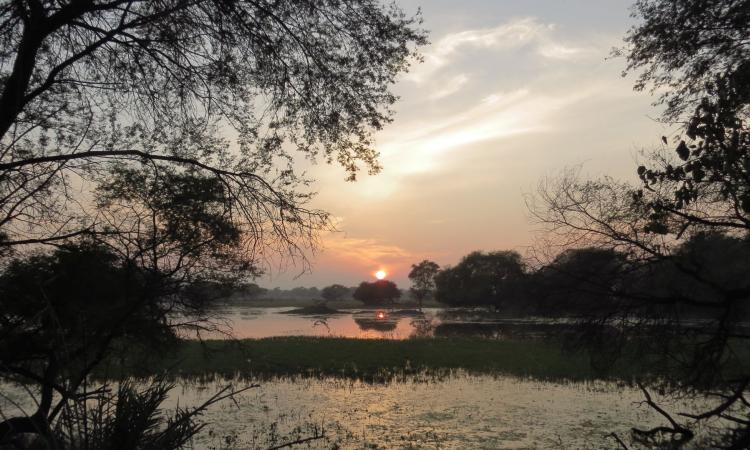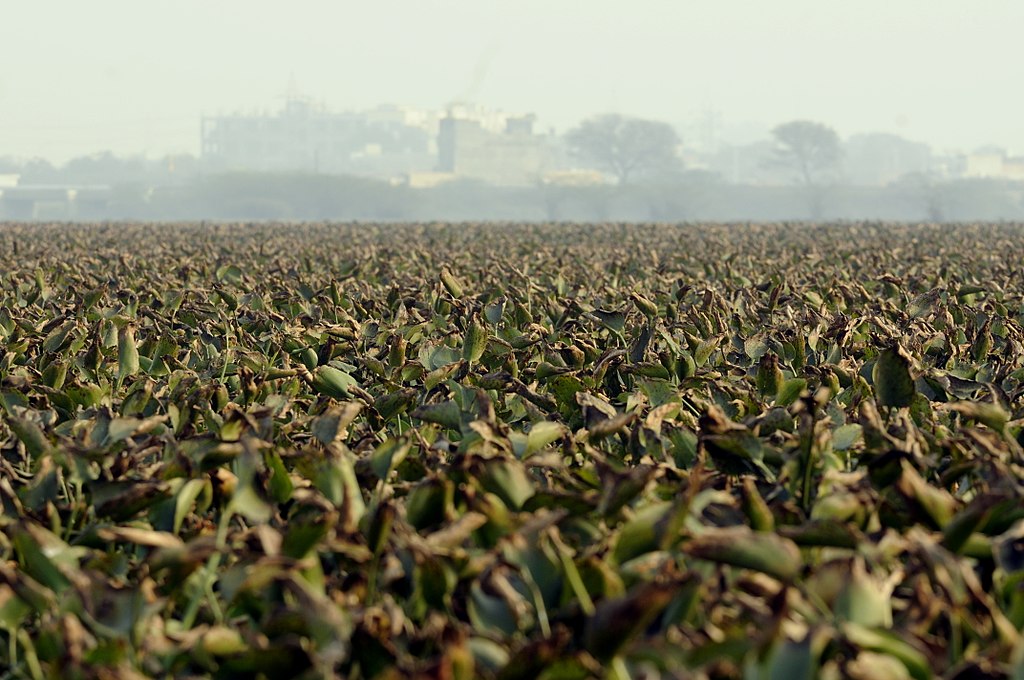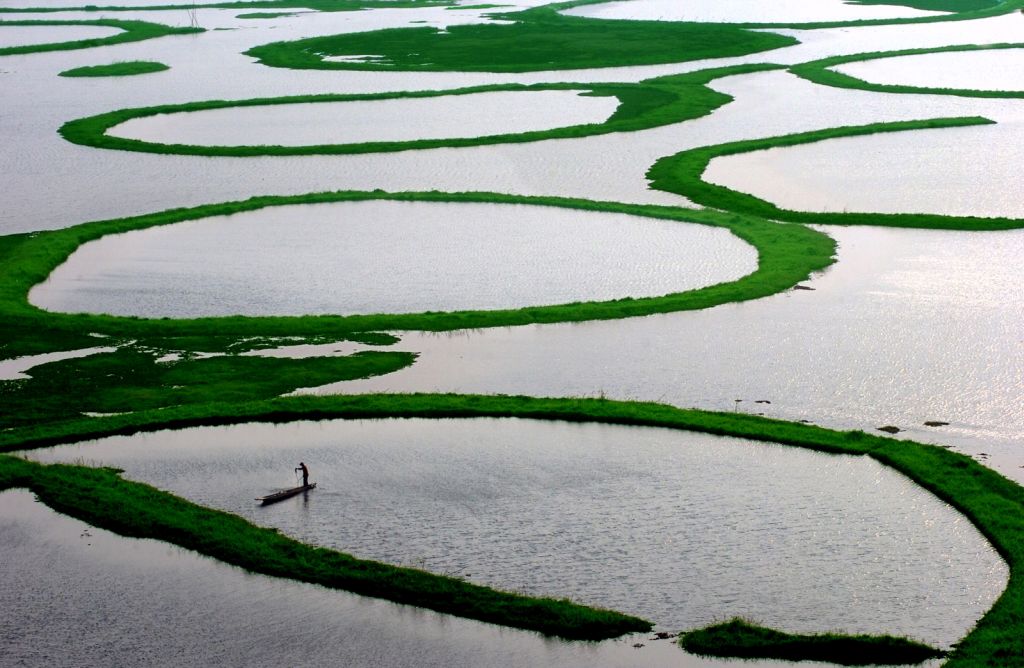
In the afternoons these days, Basai wears a deserted look. Known as a bird’s delight and privileged by the protected status of a national park, the wetland is located just eight kilometres from Sultanpur bird sanctuary in Gurugram in Haryana. No birds can be spotted foraging the soil of the Basai wetland or its waters. “Till a few years ago, the area was host to a constantly changing cast of wetland birds. Last year, some 240 species of birds were recorded at the site but bird sightings are going down year after year,” says Shubhra Puri of Gurgaon First, a non-profit working on issues related to sustainability and good governance.
Though wetlands offer a variety of benefits, like protecting biodiversity, filtering our water and mitigating climate change, Basai is doomed because of its location. Placed at the heart of the millennial city, with its condominiums and highrise buildings, Basai faces the threat of habitat loss because of the proliferating real estate development in the area. “The Haryana government has begun the process of restoration of four water bodies in Gurgaon--Basai, Wazirabad, Fazilpur Jharsa and Sukhrali--and has applied for notification of these as wetlands,” says Puri.
This is a welcome move but considering Gurgaon had 388 water bodies most of which are in a frail state now due to the blocking of their natural drainage system and general neglect, this is too little too late. The decline of wetlands, also known as the kidneys of the landscape because they trap pollutants in their soils, is widespread all over the country.
The cases of other wetlands are not any different--there isn’t enough water, swamps have dried and habitats are dying. The real issue lies in the lack of policies to protect them and management neglect which must be addressed across the country.

Wetlands face neglect
“Wetlands, as the name suggests, are spaces on earth that hold water. They can be large or small sized, natural or man-made. They hold water for noticeable periods creating ecosystems with varied roles and services. But depending on the amount of rainfall or lack of it in their catchment, their wet phases might vary; this includes periods with no water at all. Thus, they form a dynamic ecosystem. Some experts include rivers within the definition of wetlands while some others do not since the dynamic nature, as marked by flows, of rivers is quite distinct, say from a lake or a pond,” says Manoj Misra, a forestry and wildlife expert and convener of Yamuna Jiye Abhiyaan, a civil society organisation dedicated to the restoration of river Yamuna.
“Wetlands provide several ecological goods and services. But, there is a tremendous stress on them from rapid urbanisation, industrialisation and agricultural intensification,” says Nitin Bassi, senior researcher at the Institute for Resource Analysis and Policy, New Delhi. A study by Bassi et al in the Journal of Hydrology shows “the shrinkage in their areal extent and decline in the hydrological, economic and ecological functions they perform.”
As per the Space Applications Centre, which prepared an inventory and atlas of all the wetlands that exist in the country in 2011, wetlands occupy some “10 million hectares (mha), or a little over three percent of the country’s geographical area (if area under wet paddy cultivation is excluded; if included, the area is 58.3 mha as per the Directory of Asian wetlands).” The MoEF, on the other hand, estimates an area of 4.1 mha (as on 1990) excluding the area under mangroves as wetlands. So, there are many opinions about what counts as wetlands and the area under it. “The water spread area of wetlands reduce significantly from post to pre-monsoon season and this has implications for total water availability in them and thereby the various functions in different seasons,” says Bassi.
“Wetlands have been abused all over India through draining, filling and levelling by people who have encroached them. This has also happened for want of effective legal protection for the wetlands,” says Misra. “We woke up to the plight of wetlands very late, around 2008. By then, we had lost significant wetlands area across the country,” says Bhim Singh Rawat of South Asia Network on Dams Rivers and People (SANDRP), a Delhi-based non-profit.
It was in 2010 that the MoEF came up with the Wetlands (Conservation and Management) Rules 2010 under the umbrella of the Environment (Protection) Act, 1986.
No wetlands notified yet
“The number of wetlands in the country, as per the response to a question raised in the Rajya Sabha on the conservation of wetlands on July 25, 2016, is 7,57,060. Of this, 5,55,557 wetlands have an area of less than 2.25 hectare,” as per Anand Arya, a noted environmental activist and birder. Arya says, “The mapping of wetlands is important but it needs to be followed up with their notification. The wetlands rules provide legal protection and prohibit activities that damage wetlands but the problem is that not a single wetland has been notified in Delhi-NCR under the wetlands rules since the rules came into force--an important aspect the governments have ignored all these years.”
“There are no regulatory frameworks for wetlands conservation in India barring the wetlands rules. Even now, only a few selected wetlands are governed by the programme initiated as per the international commitment, Ramsar Convention on Wetlands (an intergovernmental treaty that provides the framework for national action and international cooperation for the conservation and wise use of wetlands and their resources signed in Ramsar, Iran, in 1971). There are 26 Ramsar sites in India. Thus, a majority of wetlands continue to remain out of the conservation domain,” says Bassi.
There are multiple agencies who deal with wetlands right from the forest department to the public works department but none of them have clear cut accountability.
Attempt at diluting the wetlands rules
“Instead of implementing the wetlands rules, 2010, the government went ahead with the development of the Draft Wetland (Conservation and Management) Rules 2016. This was done to purportedly decentralise wetlands management to states, on the plea that 2010 rules were poorly implemented across states, barring in Odisha. There were malafide intentions behind this move meant to put at risk wetland conservation in India,” says Arya.
 “A number of activists led by the SANDRP have demanded that the draft rules of 2016 be scrapped entirely by the MoEF as they are seriously watered down. This can jeopardise wetland conservation in the country and need to be rejected in their entirety,” says Rawat.
“A number of activists led by the SANDRP have demanded that the draft rules of 2016 be scrapped entirely by the MoEF as they are seriously watered down. This can jeopardise wetland conservation in the country and need to be rejected in their entirety,” says Rawat.
The wetlands rules was clear on activities that needed to be restricted like reclamation, setting up industries in the vicinity, solid waste dumping, manufacture or storage of hazardous substances, discharge of untreated effluents, any permanent construction, etc. within the wetlands. The rules also regulated activities like hydraulic alterations, unsustainable grazing, harvesting of resources, releasing treated effluents, aquaculture, agriculture and dredging. The draft rules of 2016 are ambiguous on these. In a letter to the ministry, SANDRP had taken serious objection to the draft rules. The specific points of objection included the fact that new rules have cut down on the role of the local communities and non-governmental members in the central and state wetland authorities.
The 2010 rules do not provide a time frame to the state governments to notify wetlands. They do not clearly mention what constitutes harmful activities in and around the wetlands, neither do they have strict provisions to restrict the violations of rules or mandate the requirement for conducting Environmental Impact Assessment, as per the SANDRP petition.
The draft rules says the power to identify and notify wetlands were to be vested with the chief ministers and the state wetland authority was eligible to propose and notify wetlands after accepting or rejecting recommendations. The states have a “dismal track record” when it comes to protecting wetlands, the SANDRP petition says. The rules would permit the states to notify wetlands in any manner they see fit, as there are no criteria or guidelines given on the matter. Even after seven years of notifying wetlands rules of 2010, there is no initiative from the states on preparing a wetlands conservation plan.
Further, there is no mention of activities that should be regulated or prohibited on wetlands. Besides, the MoEF did not consult experts while formulating the new draft rules. “SANDRP has called for new rules to be constituted through a participatory consulting process and for the 2010 rules to be implemented in the interim,” says Rawat.
Court’s take on wetlands conservation
“What was the need for coming up with new rules when the main wetlands case and 18 cases dealing with wetlands being heard in the National Green Tribunal (NGT)?” asks Arya. Arya had filed a petition, Anand Arya vs. Union of India & others (Original Application 501 of 2015) to ensure implementation of the wetlands rules and the protection of wetlands of the country. This was clubbed with a related petition--Pushp Jain vs UoI & others (Original Application 560 of 2015) in the Principal Bench of the NGT in Delhi and both are mostly being heard together.
The NGT has time and again pulled up the MoEF and the state governments for not taking effective steps to protect wetlands and identify and notify them. In one of its directions on July 22, 2016 the NGT has asked the states to mention if they have notified the wetlands as well as the proposed course of action for doing so. The states are also supposed to indicate how many wetlands have been identified and how many of them fall in the protected or non-protected area with reference to the size of each wetland.
But the states are disinclined. “The central government is still unable to draft and implement effective wetland conservation laws. They are still waiting for a meaningful regulatory framework. Landmark judicial decisions have failed to wake the reluctant state governments from their slumber. Today, we have a peculiar situation, there is no institutional structure and mechanism to protect the wetlands from rampant abuse and encroachments in the country,” says Rawat.
What can be done?
“There is a need to maintain the hydrological and ecological integrity of wetlands and for that, large-scale land-use changes in the catchment area of wetlands and pollution need to be prevented,” says Bassi. “There is a need to generate reliable data on the present condition of wetlands as regards the water quality status. This will help in devising and monitoring schemes for the improvement in water quality management,” adds Bassi.
The legal and policy framework need not be the starting point for a set of activities that involve the protection and conservation of wetlands. Till we come up with appropriate institutional and policy measures for wetland protection, we can still undertake technical measures for protecting them as water bodies,” says Shubhra Puri.
“State governments and politicians should be educated on the value of wetlands. The general public also needs to be made aware of the fact that conservation of wetlands is in their own interest,” says Rawat. “The central government, without wasting any more time, should implement wetland rules, 2010 for the time being and clear the ambiguity over draft wetland rules 2016 and the National Plan for Conservation of Aquatic Ecosystem. Comprehensive wetlands rules must be formed through consultative and participatory processes,” adds Rawat.
/articles/wetlands-wait-be-saved